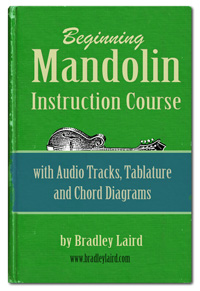|
HOME | FREE MANDOLIN CHORD CHARTS | FREE VIDEO LESSONS | FREE PODCAST FOR STUDENTS FREE BEGINNING MANDOLIN LESSONS | FREE MANDOLIN TABS | BRAD'S eBOOKS |
||||
Come
browse Brad's mandolin books here... 
©2020 Bradley Laird |
FREE
MANDOLIN LESSON 9 - by Bradley Laird
The major arpeggio contains all of the notes used in forming the major chord. All we have to do is find them on the fingerboard. The notes are A, C#, E, and A. Since the 8th note is the same as the first, just played higher it is called an octave of the lowest note. Here now is the A major scale extended to two complete octaves.
And here is a chord chart for one way of playing an A major chord:
The numbers over the strings tell you which finger is used to fret the note on that string. If you see an "X" over a string it means that you do not play that string. Notice that the first finger is supposed to play the 4th and 3rd string. Sometimes, in order to reach certain notes, you lay the first finger flat across the strings. This is called a "barre" chord. The first finger actually lays on all 4 strings. Play each of the notes of the chord individually and you will find that every note is one of the 3 notes of the A arpeggio. Either, A, C# or E which are notes 1, 3 and 5 of the major scale. There are several ways to form an A chord on a mandolin, and we will learn them shortly. (If you can't wait, jump ahead to the free chord charts.) But, they always use some combination of those three key notes of the arpeggio. When that makes sense move along to Lesson 10.
| |||






